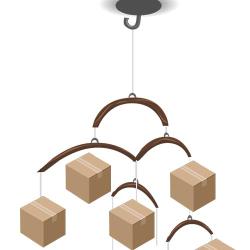Source Institutions
Source Institutions
Add to list Go to activity
Activity link broken? See if it's at the internet archive

Learners display their findings after a study of surface area and volume. They build a mobile to show a commercially available box and a constructed cubical box of the same volume. Learners also display the pieces left over from the original box showing that the cubical box has less surface area. This activity requires learners to have previous knowledge of calculating surface area and volume. Activity time can be divided over multiple meetings.
- Under 5 minutes
- 1 to 2 hours
- 1 cent - $1 per student
- Ages 11 - 14
- Activity, Lesson/Lesson Plan
- English
Quick Guide
Materials List (per student)
- empty cereal box (or pasta, crackers, cookies, etc.)
- cubical box constructed from same kind of box as the first box
- leftover pieces from construction
- scissors
- tape (masking and transparent)
- 36-inch dowel rods that are three-sixteenths of an inch in diameter
- utility knife (can be shared)
- single-hole punch (can be shared)
- white glue and/or clear nail polish
- poster paper
- regular sewing or heavy thread
Subjects
-
Engineering and Technology
-
Engineering
- Manufacturing Engineering
-
Engineering
-
Mathematics
-
Algebra
- Equations and Inequalities
-
Geometry
- Plane Geometry
- Solid Geometry
-
Measurement
- Units of Measurement
- Size and Scale
-
Algebra
-
The Nature of Technology
- The Design Process
Audience
To use this activity, learners need to:
- see
- read
- touch
Learning styles supported:
- Involves hands-on or lab activities
Other
Components that are part of this resource:
Includes alignment to state and/or national standards:
Includes assesments for student learning:
This resource is part of:
Access Rights:
- Free access
By:
- Hebrank, Mary R.
Source Collection
- TeachEngineering
Rights:
- All rights reserved, Regents of the University of Colorado, 2013
